| |||||||
| Search Forums |
| Advanced Search |
| Go to Page... |
 |
| Search this Thread |  294,629 views |
| | #1 |
| Distinguished - BHPian  Join Date: Aug 2014 Location: Delhi-NCR
Posts: 4,299
Thanked: 71,506 Times
| Submarines of the Indian Navy "Of all the branches of the armed forces there is none that shows greater devotion and faces grimmer peril than a submariner" - Sir Winston Churchill The submarine today is a superb stealth weapon with which to exercise sea control and a means of final strategic nuclear deterrent. Water as a medium is largely opaque to most of the electromagnetic spectrum except the very low frequency segment. This makes it a wonderful medium in which to patrol unobserved. Sound waves are the best form of energy with which to search and track underwater. The nature of sound waves in water and their refraction characteristics often mean that a submarine underwater can hear a surface ship miles away while the surface ship may not, in many circumstances, detect a submarine only 3 kms away. More on this later. Science is still unraveling how sound propagates through water. This essay covers a brief history of submarines, how a submarine works, the types of submarines found in navies of today and a treatise on the Indian Naval Submarine Arm. What is not covered are sensors, submarine and anti-submarine tactics and war campaigns. Conversions such as nautical miles/kilometres, knots/kmph and feet/metres have been kept to round figures. 1 nautical mile = 1.852 kms. For convenience nomenclature used are western designations such as 'Foxtrot' or 'Charlie'. Material is from reference books listed at the end Submariners always refer to a submarine (no matter how large) as a boat and never a ship. You see ships are what the submariners sink!  INS Kalvari, the first Indian Naval submarine. She joined the fleet in December 1967. Kalvari is 'Tiger Shark' in Hindi. A Foxtrot class Soviet design she was built for reliability and very long range. The Foxtrots had an underwater snorkeling range of 11,000 nautical miles (~20,000 kms) with reserves. She was the first of 8. The Foxtrots laid the foundation of training and tactics for the Indian Naval Submarine Arm. More on the Foxtrots later. MILESTONES  1776, The Turtle:The first workable submarine was invented by an American, David Bushnell and used against the British navy without success in the American War of Independence. It was operated thrice by Sargent Ezra Lee fighting for General George Washington. The idea was to get close enough to an enemy warship and attach a large dynamite under the hull. Propulsion was by human power pedaling furiously to turn a propeller with a speed claimed to be 5 kmph. The Turtle was about 10 feet by 6 feet and consisted of two wooden shells covered with tar and reinforced with steel bands. It dived by allowing water into a bilge tank at the bottom of the vessel and ascended by pushing water out through a hand pump (hard work I presume!). Manned and operated by one person, the vessel contained enough air for about thirty minutes. While the Turtle did not achieve any military success it demonstrated what could be achieved as far back as 1776. 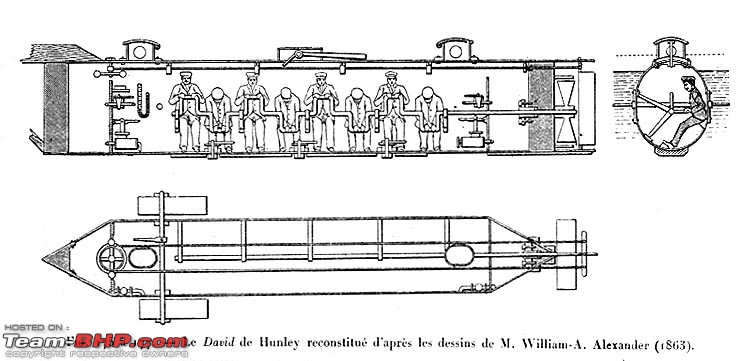 1864, C.S.S Hunley: In 1864, during the American civil war, the C.S.S. Hunley of the Confederate Navy attacked U.S.S. Housatonic of the American navy – which then became the first warship ever sunk by a submarine. However, CSS Hunley was also lost, with all hands, along with its victim. The Hunley had a crew of eight, seven to turn the hand-cranked propeller and one to steer the boat. Each end was equipped with ballast tanks that could be flooded by valves or pumped dry by hand pumps. Extra ballast was added through the use of iron weights bolted to the underside of the hull which could be released to yield extra buoyancy. Its sole weapon was a spar torpedo - a copper cylinder containing 90 pounds of dynamite attached to a 22-foot long wooden spar (i.e. a thick pole). As it had a barbed point, the spar torpedo would be jammed in the target's side by ramming. It was designed to use a mechanical trigger attached to the CSS Hunley by a cord, so that as she backed away from her victim, the torpedo would set off.  1900, USS Holland: Credit for the first really effective submarine goes to J.P.Holland, an American, whose boat U.S.S. Holland is the first modern submarine. Many of its features are still in use today - internal combustion engines for primary power, batteries for underwater propulsion, use of sea water as ballast to submerge the vessel and horizontal rudders to control the dive. Interestingly the company that built this revolutionary design, the Electric Boat Division, Connecticut continues to make nuclear powered submarines for the US Navy to this day. The USS Holland had a submerged displacement of 75 tonnes, a length of 53 feet, was powered by a petrol engine and while submerged driven by a 56kw motor. She was armed with a single torpedo tube and made 5 knots (~9 kmph) underwater. While on the surface the petrol engine charged the Exide batteries and while underwater the batteries drove the motor. If patrolling quietly she consumed only 4kw per hour at 2 knots (~3.6 kmph). Most importantly she worked. 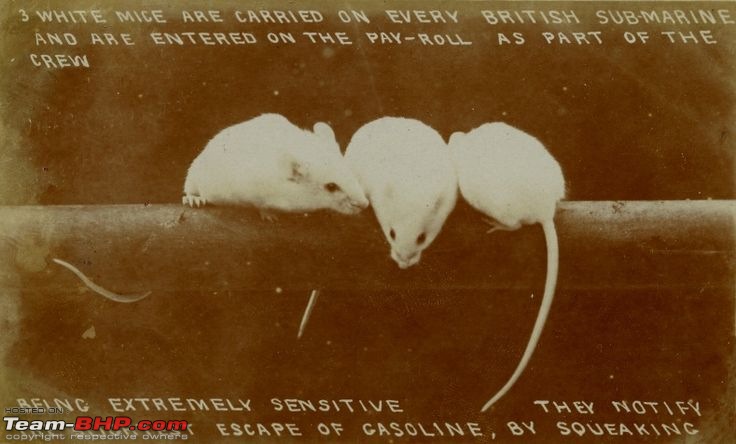 White mice on the crew roster: Early submarines were at grave risk (when cruising underwater) of hydrogen, carbon mono oxide, petrol vapour and other gases building up in the enclosed bio-sphere by use of the batteries and the time it takes to shut down the internal combustion engine in a rapid wartime dive. The British carried a few white mice as a part of the crew. Till the mice lived the levels of toxic gasses were within safe limits. If the mice squeaked incesstantly then danger levels were approaching. If the mice died it was time to surface and open the air vents! Modern day diesel electric submarines face the same risks though it is reliably learnt that the white mice are grateful that vapour detection technology has improved since 1900.  World War II Submarines: A typical submarine in WW2 was the German Type IXB shown above. By this time submarines while still similar in concept to Holland's first boat were much larger, more habitable, greatly more reliable and a real weapon to fear. However speed underwater was still usually below 8 knots (~14 kmph), endurance underwater was 16 to 48 hours at the most and the only source of air to breathe underwater was the air inside the submarine which soon got laden with carbon dioxide, water vapour and exotic human smells. Devices such as oxygen generators and carbon dioxide & water vapour scrubbers came later. A submarine was essentially a low slung surface vessel capable of short periods underwater when executing an attack or stalking or escaping. Submarines came up to the surface to run their diesels and charge the batteries every other day or so. Note the ship like hull of this boat, the non-streamlined shape, the many noisy free flood holes and drag producing protrusions & guns. As these vessels cruised rather slowly underwater the drag was not a big factor. This boat displaced ~1200 tonnes submerged, could top 7 knots underwater and sail 64 nautical miles (~118 kms) underwater at 4 knots (~7.5 kmph). In the hands of a skilled Kapitan she could dive in between 35 to 50 seconds. She carried 16 torpedoes and gun armament of 20mm for anti-aircraft defence and one 105mm surface gun to defend against enemy warships when recharging batteries on the surface. It was in one such Type IX submarine that Netaji Subhash Chandra Bose travelled from Germany to Japan to launch the Indian National Army.  1953, U.S.S. Albacore and the tear-drop hull: After World War II the Americans took the lead in revolutionizing submarine design. The cigar shaped submarines up to this time were capable of only modest underwater speeds and tended to pitch at underwater speeds above 15 knots to the point of the vessel losing all control. The Albacore was designed shaped like a blimp or airship - called tear drop in nautical parlance. Its hull was a body of revolution, that is to say, like a torpedo symmetrical around its long axis. This shape gave dynamic stability at all speeds and permitted the submarine to be 'flown' underwater like an aircraft including (it is said) being looped. This shape arrived at after studying whales and dolphins reduced power consumption by 2 to 3 times over conventional submarines. The 1800 tonne Albacore could silently patrol at 7 knots (13 kmph) using only 136hp - that's like a typical car using 1/10th of a horsepower to glide at 13 kmph. She topped at 33 knots a hitherto unheard of speed. The USSR introduced its own tear drop design 15 years later with the Victor class nuclear attack submarines. In one go USS Albacore changed the paradigms of submarine performance envelope on speed, power efficiency and maneuverability. 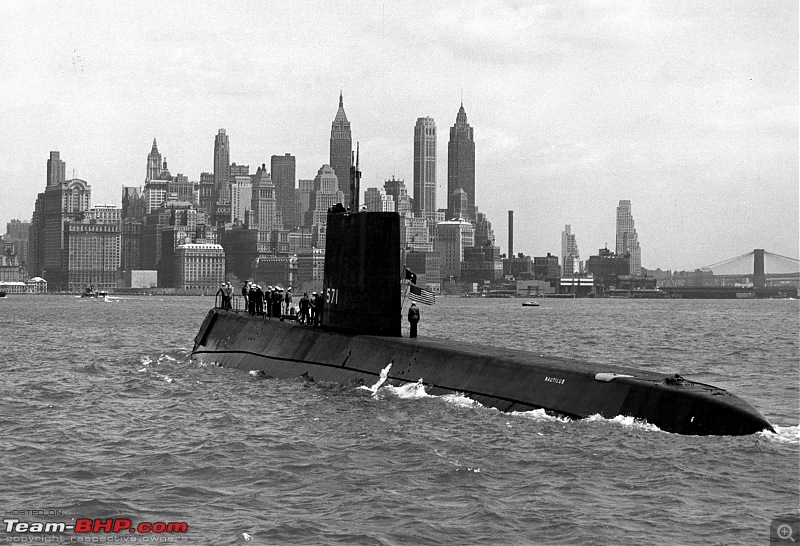 1955, U.S.S. Nautilus In 1955 USS Nautilus sent out a historic signal, "Underway on nuclear power" and ushered in the era of the true submarine that could sail limitlessly under the sea without any support from the surface. Its range was limited only by the psychological endurance of the crew and stocks of food. A typical patrol mission by a nuclear powered boat is between 60 to 90 days. Nuclear power is complicated enough without the challenge of needing to design it to fit into the tight dimensions of a submarine with an internal beam (width) and height of less than 25 feet. This boat was propelled by a reactor driving two steam turbines putting out 15,000 shp. Submerged speed of 23 knots (43 kmph) was exceptional for 1955 when diesel-electric submarines typically topped 8 to 10 knots underwater. Over a career of 25 years USS Nautilus was refueled three times. On the strength of those three nuclear cores she sailed 562,000 kms. DESIGN & LAYOUT  Submarine Hull Types: Submarine hulls come in three configurations. #3 shows the double hull style preferred by the Russians. The inner pressure hull bears the water pressure outside and retains normal atmospheric pressure inside for habitability. The outer hull made of 4mm steel is the weather hull shaped for efficient hydrodynamics. The outer weather hull affords a degree of protection to the inner pressure hull. The space in between is used by ballast tanks, anchoring equipment, sonars, torpedo tubes and other machinery that can operate under high underwater pressure. #2 shows the arrangement favoured uptill World War II wherein the ballast tanks/fuel tanks were carried on the sides of the pressure hull. #1 is the single hull mode preferred by the West. Here the pressure hull is not protected by the thinner outer hull and the ballast tanks are partly inside and partly at the fore and aft outside the pressure hull. This increases internal working space and saves weight but leaves the pressure hull more vulnerable.  A perfect sphere: The pressure hull has to be a perfect sphere with no distortions in its roundness along the entire length. When subject to immense pressures underwater the slightest departure from the perfectness of the sphere will cause a distortion, followed by a microscopic rupture and a catastrophic implosion. When constructing submarines builders are known to re-do the welding till the accuracy of the sphere can be measured to tolerances of 1:100,000. At 300 metres under the sea a submarine hull is under water pressure of 30 atmospheres or ~31 kgs per sq centimeter or 310 tonnes per sq metre.  HOW A SUBMARINE WORKS   Buoyancy & depth control: When on the surface a submarine has positive buoyancy. To submerge a sub needs negative buoyancy. This it achieves by increasing its weight by letting sea water into the main ballast tanks. In order to surface compressed air, stored in tanks inside the pressure hull, is pumped into the main ballast tank thus increasing buoyancy by pushing out the sea water. For more precise tuning of depth control, submarines use smaller depth control tanks. The amount of water in depth control tanks can be controlled to change depth while underwater or to maintain a constant depth as outside conditions (chiefly water density) change.  Constant trim & balance: The trim tanks are used for balancing the submarine and compensate for changes in weight distribution. The torpedo trim tanks perform the same function to maintain the forward balance of the sub as it fires a torpedo and becomes lighter in the fore end. The submarine needs to constantly work to maintain perfectly neutral buoyancy as fuel, water, food, consumables get consumed. Also in the deep the hull compresses losing several tonnes of buoyancy which is balanced by pumping air into the trim tanks. The trim tanks and depth control tanks are also used to make sure the vessel's attitude on all three axes is straight. 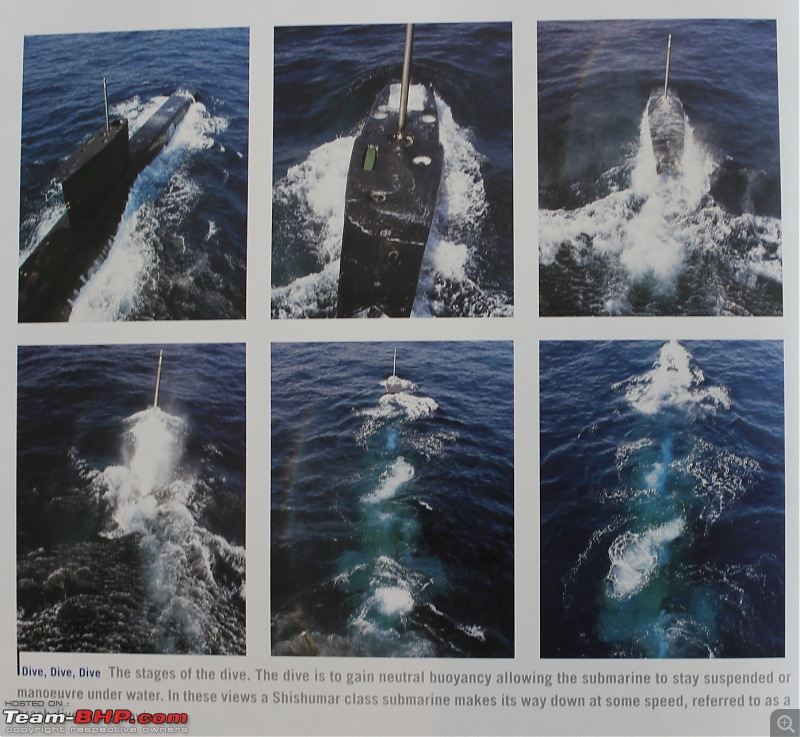 Dive, Dive, Dive. Diving is a carefully choreographed procedure executed in a calm, steady but quick manner. The sequence of 6 photos above cover about 30 to 40 seconds. There is never the melodrama you see in a war movie. In all navies submariners repeat 'dive, dive, dive' three times, on the intercom, for all to hear across the vessel.This dive sequence is of a Shishumar class (Type 1500) submarine of the Indian Navy. In Hindi Shishumar means Porpoise. Photo Source @@  Video depicting how a submarine dives using both its tanks and its hydroplanes PROPULSION 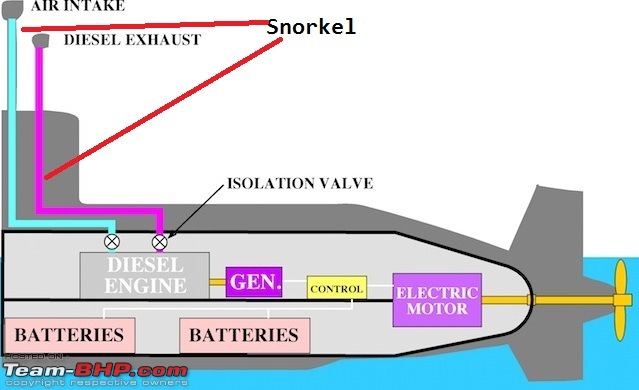 Propulsion - Diesel Electric: Most submarines even today are powered by a diesel-electric system where the diesels run a generator that charges the batteries which in turn provide the amps for the electric motor(s) that turn the propeller. All this machinery is mounted on flexible insulated rafts to limit the vibrations that get transmitted to the subs hull. Subs usually have two motors - a main motor for speeds above 4 to 5 knots and a small super silent creep motor for 4 knots and below. When on patrol at its designated station the submarine will most of the time be at 5 knots or less to remain discreet and acoustically invisible. When the batteries need to recharge the sub comes up to periscope depth (typically 18 to 22 metres) and raises up its snorkel mast and through that takes in air for the diesels and pumps out the exhaust. Diesel-Electric propulsion does not have the endurance of nuclear propulsion but it is silent. Underwater, silence is stealth; silence is an offensive asset. When running on its batteries a diesel electric sub will often hear its nuclear counterpart through passive sonar and track it long before diesel-electric sub can itself be detected. Diesel electric subs can also be built to be smaller, between 1000 to 3000 tonnes typically, this is an asset in shallow waters near the coast and at choke points like straits, harbours etc. 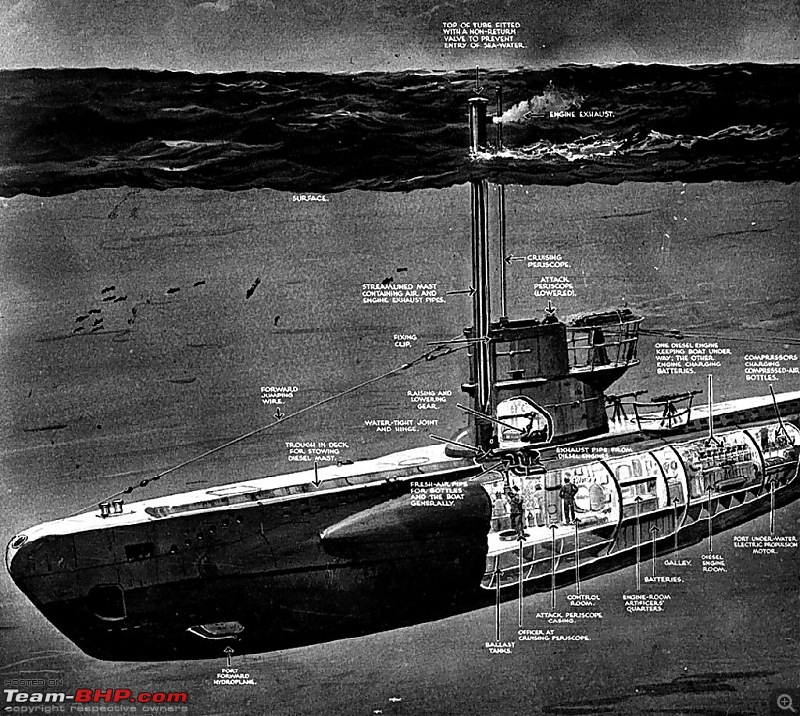 Snorkel: An artists rendition of a World War 2 submarine cruising just underwater with her snorkel raised up and batteries re-charging.  Detect that: The business end of a snorkeling submarine. The Yanks call it snorting which sounds a little gross. This is all you see of a 2500 tonne, 73 metre long, Walrus class submarine (Dutch). Picking this up amongst the waves even by radar is a tough call if the sea is a little choppy. Chances are it will be lost in the radar clutter. The snorkel was first put to use by the Dutch Navy in late 1930s. All submarines, even nuclear powered ones carry a snorkel.  Propulsion - Nuclear: Most nuclear powered submarines today use pressurized water reactors (PWR). In this water acts as the medium through which energy is transferred from the reactor and converted to run the steam turbines. Water passes around the primary circuit (shown on the left side) to covert into steam which then passes into what is known as the secondary circuit which is a marine steam turbine where the hot fast expanding steam turns the turbine which in turn turns the propeller though a transmission box. The coolant water, running on an independent circuit, is kept under pressure to cool the reactor. Submarines sail for years on a single core of uranium and used to 'refuel' twice or thrice in their lifetime of 25 to 30 years. Modern American, French & British reactors are fuelled only once at the start and that lasts them through the life of the boat. Photo Source ##  In addition to unbelievable endurance nuclear propulsion also gives submarines the capacity to carry large power plants of 15,000 shp, 20,000 shp and even 30,000 shp ranges. Married with the tear drop hull this gives nuclear submarines very high sustained speeds of 28 to 35 knots (~65 kmph) and more. This on a sustained basis makes nuclear submarines faster than surface warships today. Photo shows INS Chakra (S71) the first nuclear powered submarine leased by India from the USSR in 1988 which helped us lay the foundation of learning how to operate a nuclear sub and make our mistakes on the learning curve while being guided by the Soviets. The demise of the USSR in 1991 also ended the lease. The photo shows the enormous effort needed to cut through water as INS Chakra makes speed. In water speed and power are a cube function ie 2X speed = 8X power; 3X speed = 27X power.  Air Independent Propulsion (AIP): Three air independent propulsion systems have come up in the last 15 years. All depend on carrying quantities of stored oxygen inside the sub and combining it with a fuel in highly controlled way. The first are hydrogen fuel cells preferred by the Germans. The second is a closed cycle stirling engine developed by the Swedes and the third is the Mesma closed cycle steam turbine engine from France. The first two are operational but still evolving to full maturity. Complexity and risk of carrying liquid oxygen in cryogenic tanks and expulsion of waste gases underwater at immense pressure are the primary challenges of AIP systems. They could be the way of the future for non-nuclear boats. 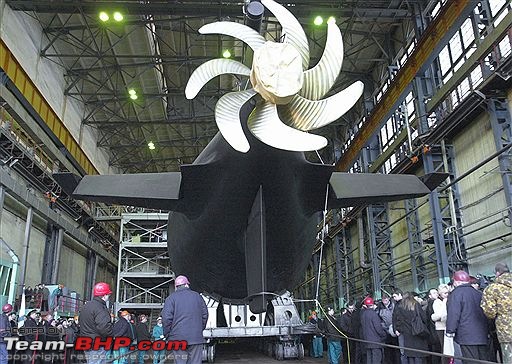 Propellers: The business end of the propulsion train. Today most submarines carry a single large slow turning propeller to maximize thrust with the lowest possible noise. For submarines silence is an asset by which to hide and still detect the target (usually a ship) by simply listening. A diesel-electric submarine patrolling at 4 knots is almost silent and very very hard to detect especially if it gets down to 250 metres or more and lies below one or more thermal/acoustic layers of seawater. The fast turning propeller starts to cavitate i.e. thousands of low pressure voids form at its blade surface which then implode with a thousand pops a minute causing a loud thrashing sound which can be picked up and beamed onto. At slow speeds of 4 to 5 knots the cavitation is minimal to non-existent. How fast is fast: Speed, depth and battery power are figures submariners do not share and for good reason. Submarines are the first and still the ultimate stealth service and the veil of secrecy helps them do their jobs. The US Navy only acknowledges that its nuclear boats go 25+knots. Conventional diesel-electric boats typically top between 18 to 22 knots (33 to 40kmph) underwater and 15 to 18 knots on the surface. The latest Japanese diesel-electrics however are believed to top 25 knots (46kmph). Similarly most nuclear powered attack submarines will have a sustained top speed in excess of 30 knots (56kmph) and some are known to go above 35 knots (65 kmph) sustained. The fastest was a Soviet Alfa class (only a couple were built) which was clocked at 44 knots (81 kmph). Why are nuclear powered submarines faster than warships: Hydrodynamics for a fully submerged object like a submarine are very different from those of a partly submerged object like a ship. A submarine has water flowing around it and over it in 3 dimensions while a ship has water flowing around it only on 2 axes. Weight for weight a tear drop shaped submarine needs about half to a third of the power needed by a surface ship to achieve the same speed. This is an approximation but directionally correct. Further, underwater, a submarine operates in an environment free from the weather and crashing waves of the surface. Hence nuclear powered boats which can carry powerful steam turbines invariably have sustained speeds equal to or more than the top speed of most warships. How Deep: Design Depth is what the submarine's military specifications ask for. This is what decides thickness of hull. As buffers of over engineering are built into these calculations the actual collapse depth is about 1.5 times the design depth. Submariners never talk about depth as that is a closely guarded fact despite modified data that is made public. Modern submarines have an 'acknowledged' design depth of between 300 to 500 metres usually. It should be assumed that publicly available figures are understated. In the 1963 the US Navy lost one of its latest nuclear submarines the USS Thresher. Four decades later when the investigation report was finally de-classified it stated that the Thresher had a normal operating depth of ~400 metres and a crush depth of ~600 metres. And this for a sub laid down almost 6 decades ago. The figures today are likely to be deeper. Relative to the depths of the oceans submarines (other than research ones) actually operate in the upper 10% of the average ocean depth. At 500 meters the pressure is a stiff ~520 tonnes per square metre. Interestingly only towards the end of WW2 could submarines start diving to depths greater than their length. 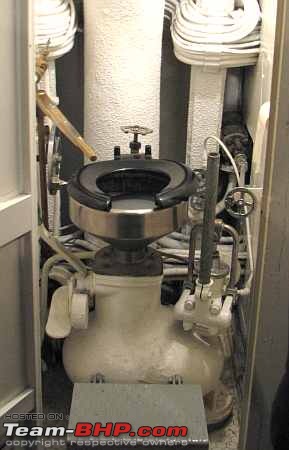 Delicate matters: Older submarines had complex water closets ie thrones. In order to discharge your stuff in the face of sea pressure or even to get it into a septic tank required an elaborate procedure of pumps, valves and levers to make sure that (a) the 'stuff' of the previous occupant didn't come flying out and (b) your 'job' went through the right way and did not splatter across the toilet. A manual from World War II on this intricate operation reads, " Before using a water closet, first inspect the installation. All valves should have been left shut. Operate the bowl flapper valve to ascertain that the expulsion chamber is empty....Shut the bowl flapper valve, flood the bowl with sea water through the sea and stop valves, and then shut both valves.... After using the toilet, operate the flapper valve to empty the contents of the bowl into the expulsion chamber, then shut the flapper valve. Charge the volume tank until the pressure is 10 pounds (per square inch) higher than the sea pressure. Open the gate and plug valves on the discharge line and operate the rocker valve to discharge the contents of the expulsion chamber overboard...." Clearly a challenge if you are in a hurry and a process designed for high risk of failure!! MAJOR TYPES OF SUBMARINES NATO's STANAG system of designation for naval vessels is commonly used across several navies now. In this system SS stands for submarine, N for nuclear powered, B for ballistic and so on. So SSN becomes Submarine, Nuclear Powered. This chapter covers the major categories of submarines extant today.  SS - Patrol Submarine. A basic diesel electric sub with attack capability limited to ships and very limited ability to detect, identify and attack another submarine. This category, which once formed the bulk of the world's fleet, is now almost extinct with only a few in service in China (reserves), Cuba, Egypt and North Korea. Photo shows one of the last SS designs, the French Daphne class. Note her cigar shaped hull, twin propellers and less streamlined look as compared to the SSK and SSN designs below. Two small propellers are several times more noisy than one large slow turning one thus making the boat susceptible to detection by passive sonar. Introduced in 1965 the Daphne, for its time was a quiet and therefore effective submarine. A Daphne class boat , PNS Hangor, of the Pakistan Navy sank INS Khukri in December 1971 in the Arabian Sea. It was the first occasion since WW2 that a submarine sank a ship in anger. the last Indian SS i.e. INS Vagli decommissioned in 2010  SSK - Attack Submarine, Diesel-Electric. These are modern super silent diesel electric powered submarines designed to attack both ships and other submarines and (now) land targets through cruise missiles. While they do not possess the unlimited underwater endurance of a nuclear powered submarine during the days or weeks they are patrolling underwater they are silent and practically very difficult to detect in the vastness of the oceans. They can wait silently at choke points or outside harbours deftly utilizing underwater thermal and acoustic layers and currents to become invisible to ship mounted sonars. In war games these submarines have created a number of unexpected upsets. In the 1980s a Dutch Walrus class boat got within striking range of the redoubtable nuclear powered carrier USS Nimitz and scored a war game 'torpedo hit' without the carrier and its formidable escorting flotilla detecting the Walrus !! Photo shows a 1100 tonne Nacken class SSK of the Swedish Navy.  SSN - Attack submarines, nuclear powered The ultimate great white shark of the seas. A true submarine that can sail underwater without surfacing for weeks and months on end only limited by food and the crews psychological endurance. Most SSNs can maintain a sustained top speed underwater much higher than the short period top speed that warships can on the surface. Some SSNs can top 35 knots (65 kmph) while a few can even sustain 40 knots (74 kmph). Nuclear Attack submarines are armed to attack ships, submarines and often land targets (through cruise missiles). As they are large there is volume for sophisticated sensors, weapon control systems, redundancies and adequate reloads of weapons. Nuclear plants are inherently nosier than diesel-electric ones especially when the latter is running on batteries. The most effective adversary for a SSN is another SSN that is quieter or a diesel electric boat patrolling on battery power. An SSN can hide beneath acoustic layers of the oceans endlessly waiting for its targets. In the Falklands war the British announced that one of their SSNs was in the area and that alone was deterrent enough to force the Argentine Navy's carrier to stay locked up in port.   SSBN - Ballistic missile armed, nuclear powered - the ultimate nuclear deterrent providers. They carry ICBMs (Inter-Continental Ballistic Missiles) to ensure a realistic second strike capability i.e. Mutually Assured Destruction (MAD). Unfortunately ballistic missiles are impotent against the non-State actors who are becoming the real enemy with their acts of terrorisim.  SSGN - Cruise missile carrier, nuclear powered: Popular with the Russians only. They were developed by the Soviets to counter dominance of the American aircraft carrier groups. The aim was to fire a ripple of long range anti-ship missiles with mini-nuclear warheads to vapourize an entire carrier group at a stroke. Today SSK's and SSN's (see above) carry anti-ship guided missiles and cruise missiles thus making this type of submarine gradually redundant. Last edited by V.Narayan : 27th March 2016 at 14:28. Reason: Final editing, punctuations |
| |  (53)
Thanks (53)
Thanks
|
| The following 53 BHPians Thank V.Narayan for this useful post: | aah78, Abhinav V, alpha1, AlphaLamb, anilntny, ankan.m.blr, anshuman_v, Aragorn, aravind511, arjab, ashpalio, ast.ggn, barcalad, Chethan B G, CliffHanger, coolvenk, Cyborg, digitalsuresh, directinjection, FlashMustang, Foxbat, gearedup, gschandra, GTO, IcarusMan, khoj, Leoshashi, LordSharan, mazda4life, Merchant58, mnvvishwa, nairrk, Nempuguru, peterjim13, phamilyman, Piyadassi, R2D2, raghu.t.k, raghubhaskar, Rajeevraj, rehaan2, Renjith_Mani, S2!!!, sabret00the, SILVER-ARROW, Srikanthan, Su-47, Swerve, The Observer, theexperthand, Top-Gear, Voodooblaster, ysjoy |
| |
| | #2 |
| Distinguished - BHPian  Join Date: Aug 2014 Location: Delhi-NCR
Posts: 4,299
Thanked: 71,506 Times
| re: Submarines of the Indian Navy SUBMARINE WEAPONS Torpedoes 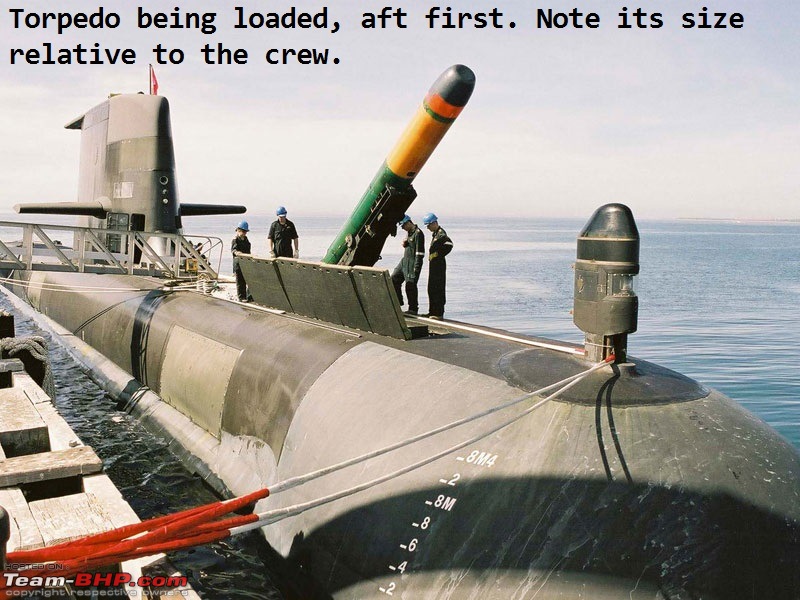  The offensive weapon of choice for a submarine to take on another submarine or a surface vessel. A torpedo would carry its own sonar, active and/or passive with systems to home onto the target or even onto the propeller wake a ship leaves behind. Most torpedoes have a trailing wire to keep connected to the mother submarine for mid-course corrections and to insulate it from counter measures from the intended target. Torpedoes typically have top speeds in the 40 knot to 65 knot range and at a slower speed could have a range out to 25 to 60 kms. These are indicative estimates as real capabilities are rarely released. Today submarine launched torpedoes, with one Russian exception, are almost universally 533mm or 324mm in diameter, 20 to 25 feet long and broadly in the 2 tonne weight class. Torpedoes are powered, usually, by batteries but more recent ones from UK and Russia have a miniature gas turbine with the torpedo carrying its own oxygen cell for the combustion. Anti-ship missiles In the early 1980s anti-ship missiles custom made for submarine launch entered service with the Americans and the French. Here a regular anti-ship sea-skimming missile is launched, from a torpedo tube, encapsulated in a buoyant water tight container. The container gets to the surface at which point the missiles turbo-jet/rocket motor fires and propels it out into open air and starts its sea skimming attack flight path. 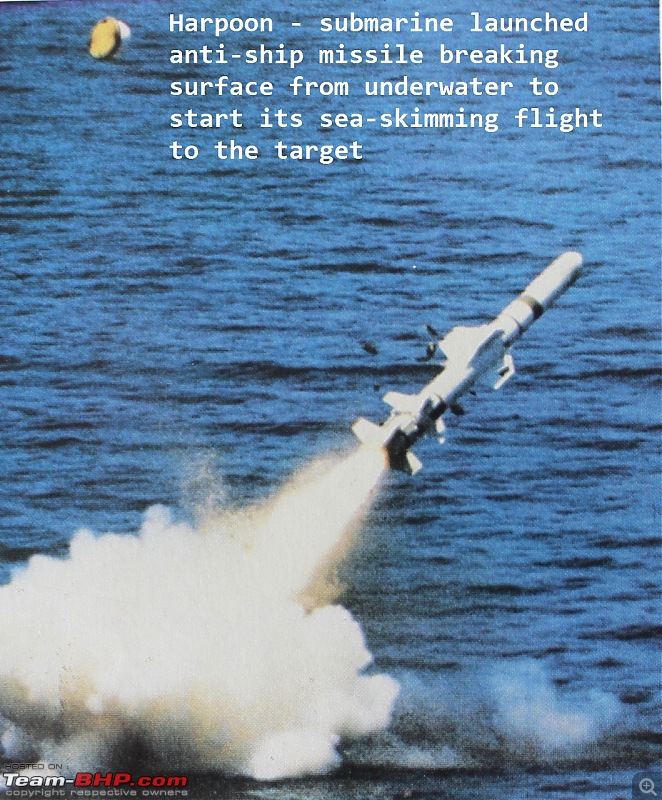 A Harpoon submarine launched anti-ship missile breaking surface. The top part of its water tight container is seen flying off. Sea-skimmers are notoriously difficult to detect. They fly fast (800 to 1000 kmph) and if attacking a target say 40 kms away the time from breaking surface to hitting the ship is in the 2 to 3 minute bracket giving the target precious little time to become aware that it is under attack, then figure out from where and by what and then take counter action. Their very small frontal radar signature helps sea skimmers hide in the radar clutter of the waves. Only a fully automated protection system of anti-missile radar-gun-missile combination can protect a ship from a sea skimmer.Photo Source ##  The sequence of operation of a submarine launched Harpoon sea skimmer. Current marks of the Harpoon have effective range in the 250kms to 280kms bracket. The Indian Navy deploys the aircraft launched version of the Harpoon. Photo Source ## Mines Mines are weapons of denial. Laying a bed of mines or simply stating that you have is a deterrent to shipping in that area or through that choke point. All submarines today can carry mines usually two in place of a torpedo. Mines are of various kinds - magnetic, acoustic, pressure, time based or even a combination. PNS Ghazi was laying a minefield on December 3rd, 1971 at the mouth of Vizag harbor when she blew up and sunk. You can read the full story in post #38 at http://www.team-bhp.com/forum/commer...an-navy-3.html Cruise missiles Submarine launched cruise missiles are the larger longer legged cousins of the submarine launched anti-ship missile. The cruise missiles started off in earnest under the Soviets as long range weapons aimed at American carrier task forces. Today they have evolved as long range land attack missiles with, often, additional anti-ship capability. For land attack a cruise missile will use some form of terrain countour matching to guide it to its target. Cruise missiles fly low and often use small aircraft engines (instead of rocket motors) to get long legs - just to be clear a rocket motor carries its own fuel+oxygen source while a aircraft engine draws oxygen from the atmosphere thus leaving more space for fuel. Simply put in a missile, for a given weight & size, a rocket motor gives speed while an aircraft engine gives range. The most widely used cruise missile is the U.S. Tomahawk made famous in the first Gulf War in 1991. Submarine launched cruise missile users are USA, UK, Russia, India & South Korea only to best of my knowledge. The Indo-Russian Brahmos is the world's fastest cruise missile. The dividing line between cruise missiles and anti-ship missiles is getting blurred as technology advances. 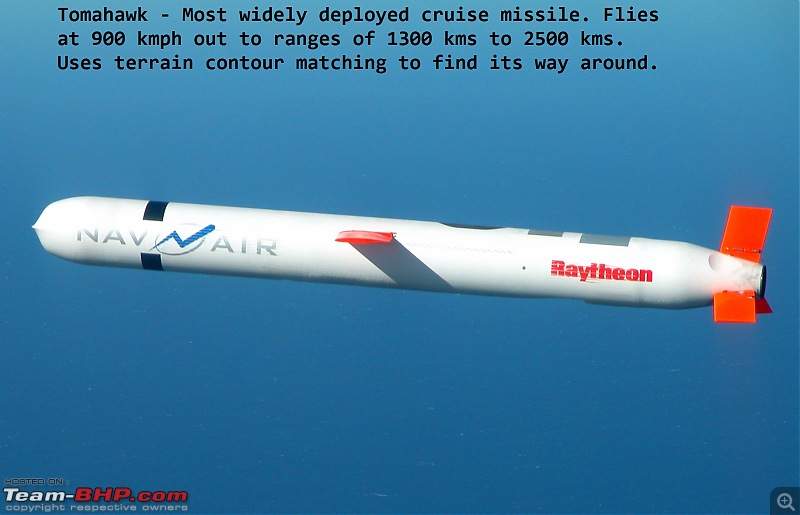 Ballistic Missiles Submarine launched ballistic missiles have been of great strategic importance for the USA, Russia, and other nuclear powers as they can hide from reconnaissance satellites and fire their nuclear weapons with virtual impunity. This makes them immune to a first strike directed against nuclear forces, allowing each side to maintain the capability to launch a devastating retaliatory strike, even if all land-based missiles have been destroyed. This relieves each side of the necessity to adopt a launch on warning posture, with its grave attendant risk of accidental nuclear war. Ballistic missiles, carrying nuclear warheads, launch from underwater into near orbit altitudes and then descend down in a ballistic trajectory onto the target re-entering the atmosphere at several times the speed of sound. These missiles typically have ranges between 5000 kms to 12,000 kms, weigh between 40 to 60 tonnes and carry between 1 to 12 warheads apiece. 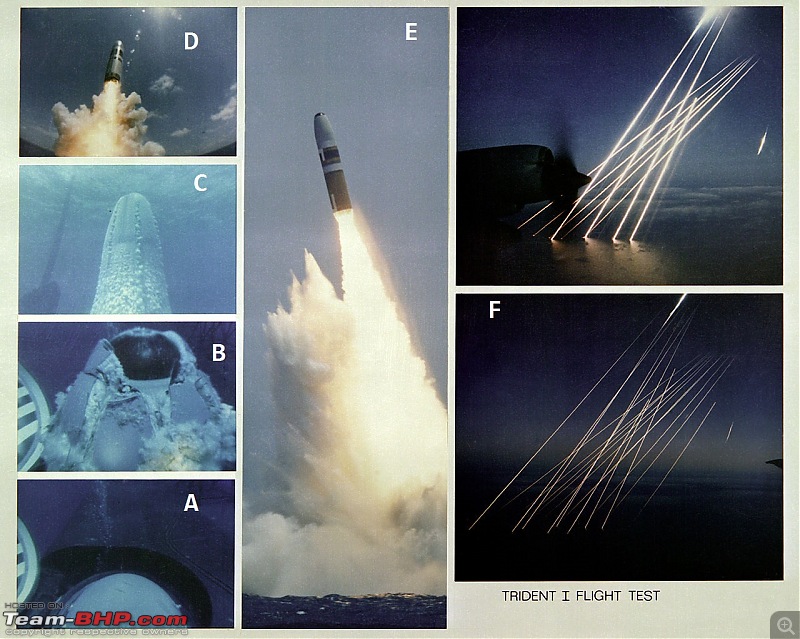 Photo sequence of a Trident inter-continental ballistic missile being launched from a submarine. A - missile container hatch opens underwater. Submarine at periscope depth i.e. ~22 metres; B - missile just starts to emerge pushed out by compressed air; C - missile ascends slowly out of the submarine's wake. You can see the fin and raised periscope on the left; D - booster motor fires to push the missile clear into the air; E - main rocket fires and missile starts its ascent into near space; F - warheads re-entry onto target. THE INDIAN NAVAL SUBMARINE ARM 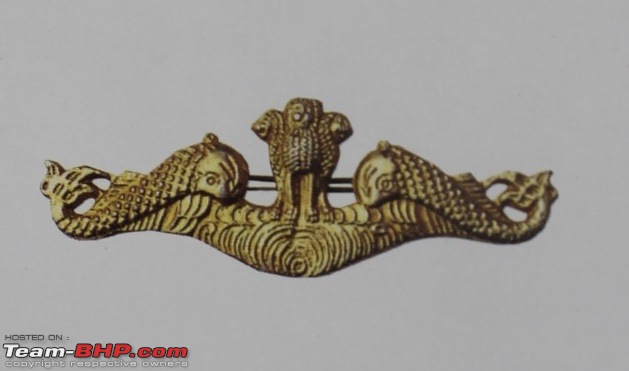 The proud badge which submariners of the Indian Navy wear above their line of medals shows one dolphin on either side of the emblem of the Indian Republic - the lions atop the Ashoka Pillar. Photo source @@ Early struggle to form the Submarine Arm The Indian Navy was keen, in the 1950s, to form a submarine force albeit of one submarine for purposes of training and giving the surface warships some real practice at anti-submarine exercises. The political leadership especially Pandit Nehru was not keen on acquiring patently offensive weapons such as submarines and the British, then our only source of material, were not keen on providing one. Our attempts to buy a second hand vessel also came to nothing when all that the British would share was a World War II boat at the end of its life. In 1962 we finally proposed to buy a brand new Oberon class submarine, then the latest the British had at GBP 5 million provided the British Government would provide soft credit to ease our then tough forex situation. Training of the first batch of officers and sailors started in earnest in UK but the credit did not come through and the deal petered off. One good that came out was a thorough 12 month training of a core group with lots of sea time and practical watch keeping. Our Navy was so closely intertwined with the Royal Navy in those days and so many Indian personnel went to the UK for training that to their credit the British submariners treated our men as a full part of the crew and gave them real experience of handling a boat. After the 1962 debacle with China the Americans and the British were willing to sell us Army and Air Force equipment (to defend against the Chinese) but not submarines. In 1964 Harold Wilson the British PM sardonically told YB Chavan our Defence Minister, "I did not know that submarines climbed mountains". Soviet coup de grace To cut a long story short the Soviets were willing to sell us their then latest diesel-electric submarine the Foxtrot class (Russian designation I-641). A quick review by the Indian Navy indicated that the Soviet subs were as good as the British Oberon and came at a price of Rs 3 crores a piece paid for in Rupees and not USD. YB Chavan and the then Naval Chief BS Soman moved fast and closed the deal in 1965. This was encouraged by the aggression by Pakistan in 1965 who had received their first sub PNS Ghazi from the Yanks and by Indonesia who encouraged by the Chinese were building a naval fleet, constantly intruding into the Andaman-Nicobar waters and had declared that the Indian ocean should be renamed the Indonesian ocean. Today when we are a stable democracy and recognized large economy all this sounds like a lifetime away. But such were the realities of geo-politics of newly independent countries with the over arching background of the cold war. For the sake of a small GBP 5 million of soft credit the British lost our custom altogether at least where subs are concerned. Lord Louis Mountbatten tried to intercede on our behalf as he realized this would push the Indian Navy into the Soviet sphere but to no avail. Why blame the British. Our bureaucracy is also capable of wearing horse blinkers and inflicting strategic blunders as we will see in a few paragraphs. Remember these events took place 8 to 17 years after independence. The glow of colonialism still hung over the world. The British wrongly assessed we had no choice but to do their bidding. And they were clear about not willing to aid an emerging leader of the non-aligned world with an offensive force like a submarine arm. We were hesitant to deal with the Soviets initially but gradually bridges of deep friendships got built between the Soviet & Indian Navies. Foxtrots  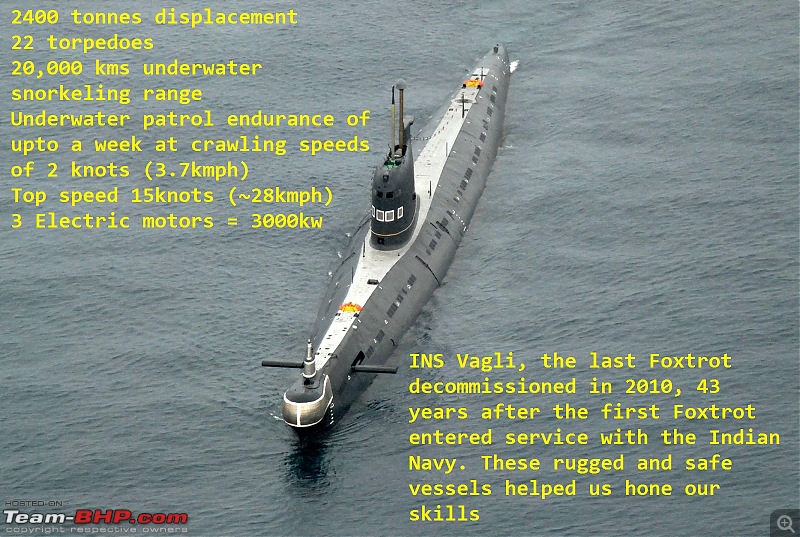 Any one who has visited a Foxtrot cannot but fall in love with this simple and superbly designed boat. Very Soviet in character cramming more machinery, batteries and torpedoes in a given space than Western navies can dream of. In the Foxtrots you could not bathe for the entire duration of the patrol. Period. It was like living and working inside a machine. The Soviets to their credit gave us their most evolved and reliable design that worked well for our fledgling submarine force to learn their trade on. The Foxtrot's snorkeling range in real world terms means it could, if needed, sail from India to the North China coast, patrol there for 3 weeks and return back without refueling. I don't know if this was ever practiced. With the Foxtrots our surface Navy learnt how invisible a submarine can be when it can pick up a ships propeller noise 15 to 20kms away and often the ship cannot detect a submarine 3 kms away. That was true in 1967 and it is true today. In the December 1971 Indo-Pak war all 4 of the submarines then in commission were deployed off the coasts of West and East Pakistan. On the one hand their presence helped to bottle up the surviving Pakistani fleet in port, especially on the West coast off Karachi but on the other hand this blockade denied our submarines the chance of drawing blood.  We bought 8 boats. I wish we had purchased 12 or 14 as those were days of Rupee-Rouble trade and the Soviets sold us at concessional prices. But sadly the Navy top brass and the bureaucracy did not fully grasp the impact of a submarine. All submariners were young 'uns and the top brass had grown up on the surface warships with some rigidness to appreciate this new weapon. But fortunately that changed in the 1980s as the young submariners climbed up the ranks. Arun Auditto, as a Rear Admiral became the first Flag Officer Submarines and in the 1990s Vijay Shekhawat became the Naval Chief.  Admiral Vijay Singh Shekhawat, the first submariner to become the Naval Chief The Mother ship  Along with the Foxtrot class submarines we bought INS Amba a large submarine tender or mother ship. Mother ships are used to improve the effectiveness of submarines far from their naval base for example quietly operating out of the Nicobar islands. INS Amba provided all kinds of support to the submarines - fuel, fresh water, torpedoes, repair, provisions, electric supply, most importantly battery charging and so on. When alongside INS Amba submariners could sleep and live on board and have a bath! Photo Source $$ Soviet assistance We have to hand it to the Russians. They not only gave us 8 brand new of their then best conventional subs but also helped us commission the entire infrastructure needed to operate and maintain a submarine force. In the 1960s and 1970s with their assistance we set up a training school, diving school, repair facilities, torpedo maintenance workshops, dockyard support for submarines, inducted the submarine rescue ship INS Nistar et al. The training they imparted was very detailed and thorough and after some resistance they worked with us to modify the training to include more practical time and to reflect the way our Navy is organized. India's geo-political situation and relationship with the Russians has changed and the Russians themselves have changed. But in the 1960s, 1970s and 1980s they helped us like no other. What makes submarines a feared and respected instrument of deterrence The oceans are not a quiet place. They are full of noises - whale songs, ship propellers, oil rig noises, natural geological sounds and what have you. Thus there is an ambient sound in the oceans and if a submarine can make itself quiet enough to merge with this ambient hum it can become acoustically invisible. Diesel-electric submarines, when running on their batteries, especially below 5 knots (~9kmph), acoustically merge with the environment. Electromagnetic waves are attenuated as they enter the oceans. Sound is the only form of energy that can be harnessed to locate or track a submarine. Sound travels about 4 times faster underwater than in the air (average of 1450 metres/second). Ocean temperature varies with depth in a non-linear way. Similarly salinity i.e. density varies with location, rainfall, proximity to river deltas etc. These two combined with currents and other oceanographic phenomena cause layers of sea water of differing density and temperature. These are called haloclines (density) and thermoclines (temperature). A sound wave hitting the intersection point of these layers refracts. These haloclines and thermoclines also create giant tunnels or ducts through which sound from a source (ie a sonar) refracts and travels sometimes horizontally and sometimes in vast three dimensional curves. Hence a surface ship could be beaming its sonar searching for the elusive submarine and not detect it sitting 300 metres right below due to this refraction. Submariners spend a lifetime learning how to hide in these sonic shadows of the oceans and wait for the quarry. The oceans cover 70% of the surface a vast and relatively unexplored part of our world. And its geology and underwater phenomena is only imperfectly understood. It is in this nether world that submarines operate and hide in. So a hunter-killer submarine chooses when to attack, where to disappear and when and where to re-appear. While it is not as simple as that it underlines the fact that the deterrent impact of a submarine is as much psychological as physical. Local production & Type 1500 -enter the Germans Our quest for building our own submarines led us to first approach the Russians in the late 1970s but they did not have a modern mid-sized tear drop design that suited our specifications. So we evaluated options from Germany, Sweden, France, Netherlands and Italy in some detail. The designs from Sweden and Germany were by far the best. As the Germans, even after World War II, had the most experience designing and building submarines for export we went with them. The German design bureau, IKL, headed by the iconic Professor Ulrich Gabler had designed the Type 209 design platform which could then be modified or grown or shrunk to suit the individual needs of a naval customer. It was also to prove to be a most reliable design over the years. The Indian Navy had IKL 'grow' the Type 209 platform to the maximum size it could absorb and come up with the Type 1500 design for the Indian Navy. Two boats, built in Germany, INS Shishumar and INS Shankush commissioned in 1986 and four were to be built in India. This IKL family of designs, in 5 variants, have become the most popular and widely built submarine family outside USA and Russia and have been employed by 14 navies across the world.  The Shishumar class or Type 1500 displaces 1850 tonnes submerged; tops 22 knots underwater; has a range of 8000 nautical miles (~14,800 kms) snorkeling at 8 knots and carries 14 torpedoes for use against both ships and submarines. By designation they are SSKs - ie diesel electric attack submarines. They are also called hunter killers as they can track and sink other submarines. Like most western submarines they are single hull vessels. Unique to any submarine in the world they carry their own escape capsule in which all 40 crew can be squeezed in and the capsule floats up to the surface through natural buoyancy. Another interesting feature is the ability to carry up to 24 mines in external strap-on saddles on the side for special mine laying missions without compromising on the torpedo load.  With German training and know-how we built two vessels INS Shalki (1992) and INS Shankul (1994). Two more were to have been built but budgetary pressures and a lack of understanding in our bureaucracy of the time and effort it takes to build national capabilities threw this opportunity away. The skilled work force and know-how developed at Mazagon Docks withered away for a decade and a half till the French Scorpene project commenced in 2009. The saving grace has been that the boats have served the Navy well and proved most reliable in service. The Germans especially Dr. Gabler and IKL worked very well with the Indian design engineers and submariners. The detailed documented history of our Navy is full of praise for Dr. Gabler's personal interest in the Type 1500 design and the thoroughness with which the Germans went to work on our project and helped us learn too. Sadly all that was lost for a couple hundred million $. Kilo Class 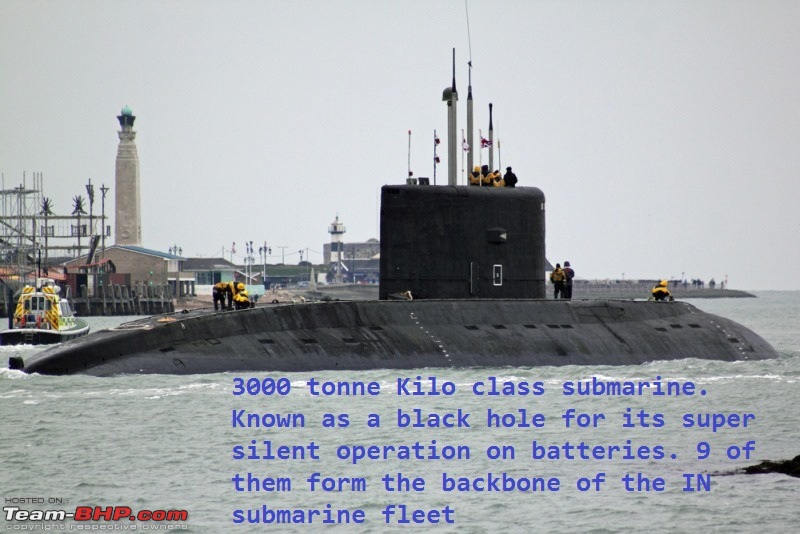 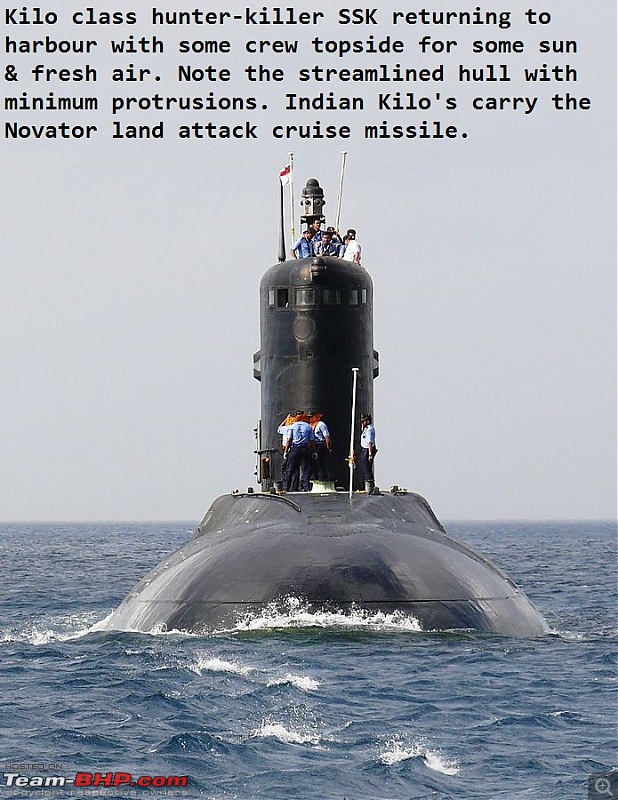 To augment the size and effectiveness of the submarine arm the Indian Navy inducted 10 Kilo class (Russian designation Type 877EKM) submarines from Russia over 1986 to 1999. In the 2500 -3000 tonne class these are very very silent SSK hunter-killers. The EKM's are believed to be covered with sound absorbing ancheoic tiles that absorb the sonar waves of a enemy sonar thus reducing the range and quality of the enemy sonar's capability to detect and identify. In war games with the US Navy EKM's of the Indian Navy are believed to have tracked and homed in on US nuke subs for hours without being picked up themselves. They are armed with 18 homing torpedoes for use against other ships or submerged submarines and can carry the Russian Novator land attack cruise missiles that go out to ~250 kms. The Kilo have the tear drop shaped hull which as you read in the first post gives outstanding hydrodynamic efficiency that leads to better maneuverability and longer endurance on batteries. They are powered by a main electric motor, a silent creep motor for patrolling and two auxiliary motors for maneuvering in shallow or confined waters and as an emergency 'get you home' back-up propulsion. The weapon systems, fire control computers, sonars, electronic counter measures suite and silent operations of these new boats are much appreciated by Indian submariners. Very capable boats but sadly two of them have been involved in accidents.  In 2013 INS Sindhurakshak exploded in Mumbai harbor killing 18 of its crew. The Board of enquiry concluded that torpedoes explosion following a fire could be the cause. At the time there were reports of old batteries which had not been replaced because the mandarins of the Ministry of Defence had been sitting on the files for years and that gasses built up from old and worn out batteries could have played a part. For 45 years the Navy has been sourcing batteries from locally manufactured Standard Batteries (now Exide) and it has worked perfectly. A new manufacturer sued the Navy for not buying batteries from them. So instead of taking a stand the MoD decided to stop all battery purchases till this was sorted out -the typical bureaucrat approach of take no decision and don't let anyone take one either. So while the commanding officer was court martialed and the Naval Chief resigned out of a sense of honour nothing happened to the worthies who sat on files. INS Chakra (Charlie class) 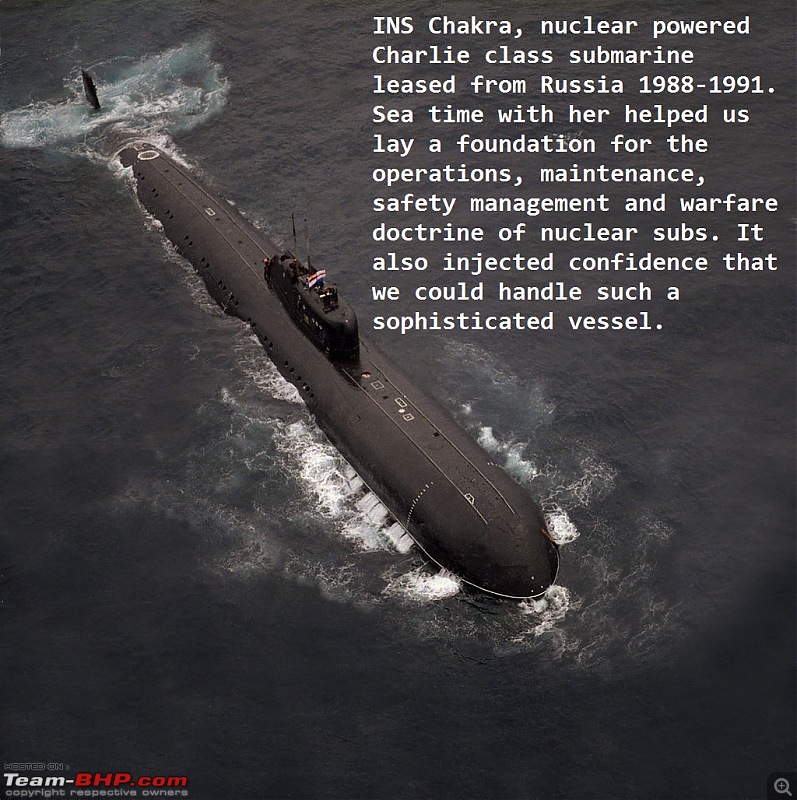 In the early 1980s we took the unprecedented step of negotiating with the Soviets about leasing a nuclear powered submarine. Nothing remotely like that had ever been contemplated before by any of the then 4 builders & operators of nuclear boats i.e. USA, UK, France and USSR. This was a very bold step, deeply frowned upon by USA and UK but received positive support from the Soviets. The long process of negotiation and training started and the specialized berthing and maintenance facility was built at Vizag. In 1988 INS Chakra a Charlie class nuclear powered submarine entered commission with the Indian Navy. It is to the credit of the Russians who trained us and our submariners who learnt well that this sophisticated vessel was operated by us for 3 years without incident. Her first skipper was Captain RN Ganesh (later Vice Admiral) a quiet and deeply proficient officer who later also commanded INS Vikrant thus becoming a rare officer in any Navy to have commanded both a nuclear submarine and an aircraft carrier. The main role on INS Chakra was to teach us how to operate a nuke boat, build our confidence and give our surface navy the opportunity to better appreciate this formidable great white shark. With the collapse of USSR in 1991 sadly this lease ended. So what are submarines used for The two primary roles of a submarine force are to ensure sea denial by making it too dangerous for ships of the opposing forces to cross an area - a strait, a narrow, a coastal area astride an important port, a major sea lane. In the first role of sea denial the aim is to sink or better threaten to sink anf opposing ship or submarine the enters the area. The second primary role is to be the final arbiter of nuclear deterrence by providing a credible secondary strike capability after the enemy has destroyed your nuclear and economic assets. In addition to these two primary roles most submarines perform several secondary but important roles of surveillance, gathering signal intelligence from the opposing coast, laying mines and supporting covert commando operations. India lies astride the Straits of Malacca to the east and the Straits of Hormuz to the west two of the most widely transited narrows on the globe. The second INS Chakra (Akula class)  In 2012 the Indian Navy leased, for 10 years, a newly built Akula II class nuclear powered attack submarine christened INS Chakra. The Akula II is the first Russian class of submarines that is quieter than the current American mainstay the Los Angles class. That is quite something as silence is a submarine's first line of both defense and offense. The Akula II is a 8000 tonne boat with a top speed of 35 knots or more and a patrol endurance of up to 90 days. With 40 torpedoes/ missiles she has the ability to sustain an engagement for long periods. The egg shaped object at the top of the after hydroplane contains a towed array sonar. This is a string of listening hydrophones trailing several kilometres behind a slow moving submarine. This enables it to listen without the ambient noise of the submarine and to listen up as well as down through the ocean searching for its target. It is reported that the Indian Navy will go in for a second boat on lease in the near future. Scorpene  To make up for the lost opportunity of building more Shishumar (Type 1500) class submarines and to augment the depletions in our submarine fleet the Govt of India after a detailed evaluation signed up to acquire 6 Scorpene class submarines to be built at Mazagon Docks, Mumbai under license from the French. The programme signed for in 2005 ran 4 years behind schedule under the UPA Govt but has now been put on track. The first of the Indian Scorpene's INS Kalvari launched in April 2015, has entered trials and is expected to join the fleet later in 2016. Appropriately she carries the name of India's first ever submarine. The Scorpene's are 2000 tonne boats with very modern weapon suite including the ability to fire the submarine launched Exocet anti-ship missile. INS Kalvari carries a mix of 18 heavy weight torpedoes and missiles. At USD 500 million a piece these are expensive boats. The cost is a reflection of the complexity of the weapon systems, the silencing measures incorporated into the design and the degree of automation to reduce the crew complement. The Indian Navy may go in for a follow on of 6 more vessels maybe with an Air-Independent Propulsion system. Like the Type 1500 and Kilo class the Scorpene's are SSK's. BrahMos, supersonic cruise missile  BrahMos is an Indo-Russian multi-platform cruise missile designed for launch from ships, submarines, aircrafts and land vehicles. With a range of 290 kms and a flight speed of Mach 2.8 (~3400 kmph) it is one of the fastest cruise missiles in service. The missile carries a conventional warhead large enough to seriously disable a large warship. Guidance is by a combination of inertial navigation, active radar and satellite course correction. The BrahMos (named for the Brahmaputra + Moskava rivers) is based on the Russian P-800 Oniks missile and borrows the propulsion motor from it and adds a wholly new guidance system and the ability to interface with multiple platforms. The BrahMos is in service with the Navy as a surface weapon. The submarine launched version was first test fired in 2013. It fires from a vertical silo and is expected to join the fleet in the medium term future when new build subs with the vertical launch facility commission. BrahMos represents an outstanding success for Indo-Russian co-operation. Sagarika, Short Range Ballistic Missile 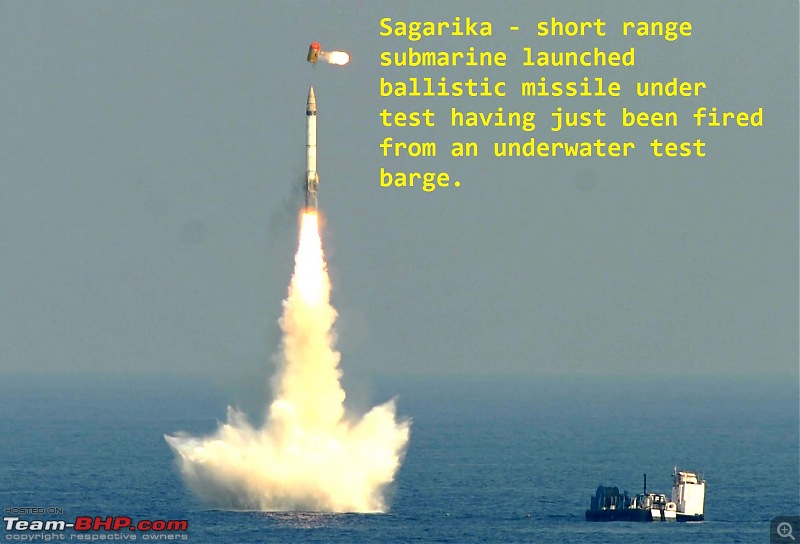 The Sagarika (also designated K-15) is a short range ballistic missile developed by DRDO and expected to be armed with a nuclear warhead. The Sagarika is expected to equip INS Arihant India's soon to be commissioned nuclear powered ballistic missile submarine. According to news reports it has a range of 750 kms. Successful tests carried out are a milestone for DRDO. 750 kms is a little short for a ballistic missile but can fully do the job considering that the Russians or Americans are not our adversaries. A longer range version is under development but that will take a few more years. INS Arihant - indigenous nuclear powered ballistic missile submarine  INS Arihant is the hallmark of the Indian Navy's long and steady journey towards indigenization and designing our own ships (and now submarines). The humble but well thought through start of this journey in the early 1960s is narrated as a photo essay on Team BHP at http://www.team-bhp.com/forum/commer...ahmaputra.html INS Arihant has been designed at home with assistance from Russia. It is a nuclear powered ballistic missile carrying submarine i.e. a SSBN. It represents the first steps towards a sea based nuclear deterrent against our two nuclear armed neighbours. As an industrial achievement it is a hallmark of indigenous capability and the marriage of 3 complex engineering components - a submarine hull, a nuclear power plant and a ballistic missile system. As per news releases this 6000 tonne boat, which carries 12 Sagarika missiles, is undergoing extensive sea trials and weapon integration trials. A final commissioning date has not been announced but could be in the very near future. More on Arihant in a future post when the Navy releases data for public consumption and commissions the mighty ship, oops boat. With the commissioning on INS Arihant India will become the 6th country to design, build and operate its own nuclear powered ballistic missile submarine. The Americans were the first in 1960, followed by the Russians in 1960 in a limited way and in 1967 with a proper SSBN, the British in 1967 (the British used an American nuclear plant and missile; really only the hull was their own design), the French in 1971 (the French went alone and developed a wholly home grown reactor and missile) and the Chinese in 1987 in a limited way and only from 2007 in a full fledged way. With INS Arihant on one hand and the new carrier INS Vikrant under construction on the other the Indian Navy can justifiably be proud of its success at developing home grown designs. A second improved version INS Aridhaman is under construction. In order to ensure that at least one ballistic missile armed submarine is out in the oceans on any given day we need a squadron of 5 vessels. http://timesofindia.indiatimes.com/i...w/51169525.cms LIFE ON BOARD AN INDIAN SUBMARINE Life on board a submarine is tough. You are literally living and working inside a giant machine with space, fresh air and fresh water at a premium. Emphasis is on getting maximum weapons, sensors, batteries and machinery into the hull at the expense of personal space and comfort. This is compounded by the demands for perfection where a single mistake by one crew can spell death for all. Working in such a demanding environment often leads to a special bond amongst submariners that lasts a lifetime.  Command centre when operating underwater. The red colour is to protect the night vision of the captain's eyes looking through the periscope. White and red light are used to simulate day & night in the sealed world inside a submarine. Photo Source @@  Maintenance of torpedo tubes at sea. All submariners practice escaping through the torpedo tubes in darkness underwater. Those who have swum at sea in the night will have some idea of how disorienting and frightening this can be. Photo Source @@ 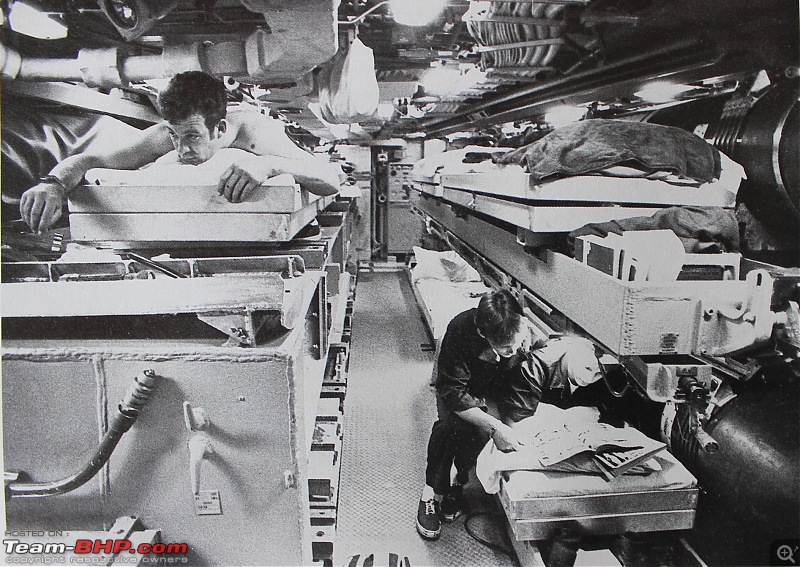 Sleeping arrangements on a submarine. Most of the crew hot bunks - 3 men share 2 bunks. Here the men sleep amid the torpedo re-loads. (This photo is from an American sub. I could not get a photo from one of our own) Photo Source ##  In some missions submarines may have to surface. While it is possible to get away from surface warships a anti-submarine helicopter can be a nasty surprise. Here a sailor on board an Indian Kilo class submarine holds a shoulder launched SAM to even the odds versus a chopper. Photo Source @@  Maintenance of the batteries at sea. The engineer crawls in with 30" of space. Battery upkeep is a vital task for both operations and submarine safety. Photo Source @@ 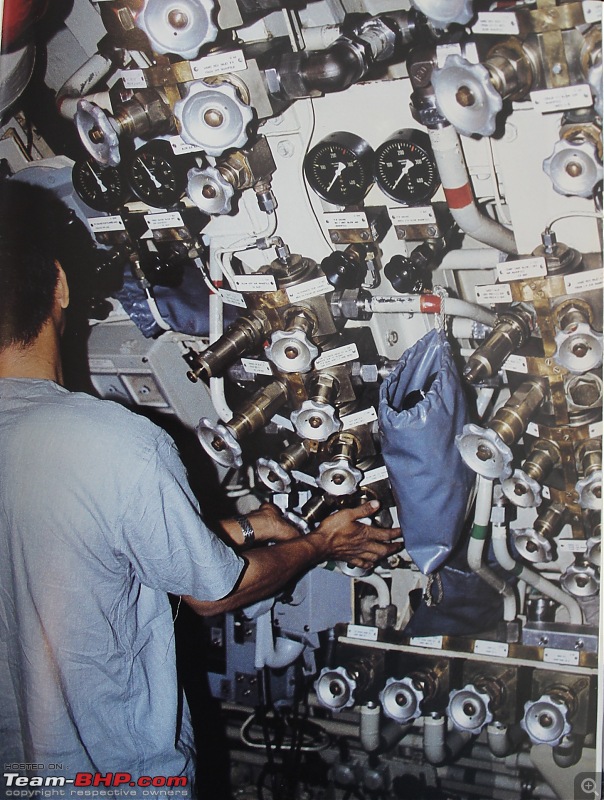 No matter how sophisticated a submarine and its electronics may get it shall always need a vast array of pumps and valves to operate the ballast tanks, trim tanks that use sea water and compressed air to dive and more importantly to surface. The panel watch keeper who controls all this in clockwork precision has to know the complex conglomeration of valves like the back of his hand. Correct operation in both sequence and timing are vital for the submarines safety each time it dives or surfaces. The watch keeper is trained to operate in total darkness. Note the disposable cotton banian-shorts he is wearing - this is the typical operating dress in the Indian Navy for submariners - no rank, no insignia - only mutual respect for each others professionalism. Photo Source @@ 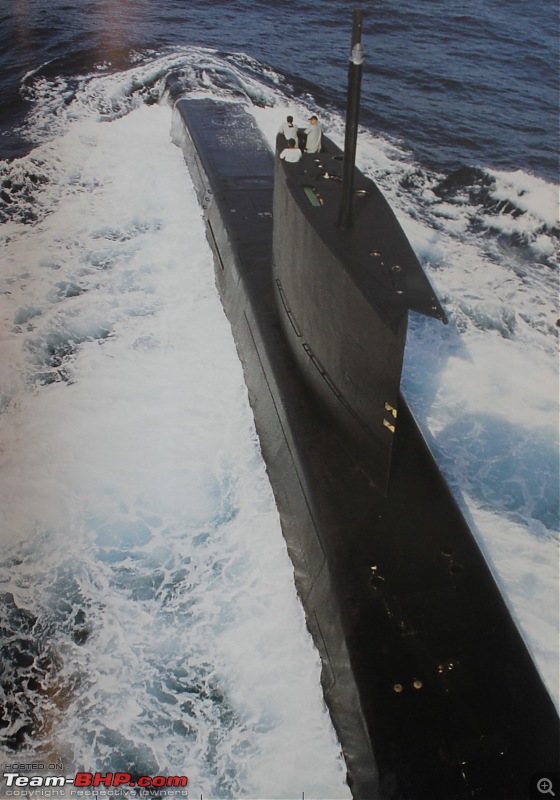 A Shishumar class submarine on the surface on way to her diving point. Note the periscope is up for use when dived. Photo Source @@ The Indian Submarine Arm has evolved combing the best of traditions of the Russians the Germans and our own into an operating philosophy suited to our environment. Over the years Admiral Gorshkov the father of the Soviet Navy did his utmost to help us develop our Submarine Arm. The same can be said of his successor Admiral Chernavin and the German Government and Navy. Our submarine fleet peaked in the early 1990s with 20 boats including the first INS Chakra. Since then Government apathy, the lost opportunity to continue building the Shishmar class Type 1500s and the delays in the Scorpene project meant a gradual erosion of force levels to 13 boats in 2011. Matters are looking up again with the new INS Chakra in commission, the new INS Kalvari expected on stream later this year and INS Arihant under trials. Submariners all over the world share a unique bond which is that, when dived, the lives of all depend on each crew member doing his job absolutely right each time without fail. Jai Hind. References Transition to Triumph, The Indian Navy 1965 to 1975 by Vice Admiral GM Hiranandani, 1999; Publisher Naval HQ & Lancers Transition to Eminence, The Indian Navy 1976 to 1990 by Vice Admiral GM Hiranandani, 2005; Publisher Naval HQ & Lancers Transition to Guardianship, The Indian Navy 1991 to 2000 by Vice Admiral GM Hiranandani, 2009; Publisher Naval HQ & Lancers The Indian Navy, A Photo Essay by Rear Admiral Raja Menon (Retd), 2000; Publisher -Naval HQ; Photo Source @@ The Submarine by Thomas Parrish, 2004; Pengiun Books, USA Modern Submarine Warfare by David Miller & John Jordan, 1987; Publisher Military Press, Salamander Books Ltd; Photo Source ## Jane's Submarines by Robert Hutchinson, 2005; Published by Harper Collins The Indian Navy, An Illustrated History, 1989; Published by Naval HQ (Source of a photo is mentioned where it has been picked out of a book. The rest have come from the internet) Last edited by V.Narayan : 27th March 2016 at 14:51. Reason: final touches |
| |  (88)
Thanks (88)
Thanks
|
| The following 88 BHPians Thank V.Narayan for this useful post: | aah78, Abhinav V, Abhi_abarth, abishek2222, Acharya, AheadAJ, Akshay1234, amit_purohit20, amyth78, anilntny, ankan.m.blr, anku94, Aragorn, aravind511, aravindkumarp, arjab, arunphilip, ashpalio, asingh1977, autoskooll, avisidhu, barcalad, blahman, Chethan B G, CliffHanger, comfortablynumb, coolvenk, Detritus, digitalsuresh, ex670c, Foxbat, girishglg, Gosu, gschandra, GTO, himanshugoswami, i74js, IcarusMan, JayKis, khoj, KK_HakunaMatata, KPS, ksubram, Lalvaz, Leoshashi, LordSharan, lovetorque, mallumowgli, manas_270, Merchant58, mi2n, mnvvishwa, mr.sinha, nairrk, Nempuguru, NPX, PapaBravo, phamilyman, Piyadassi, poised2drive, pratyush6, quantobigboot, raghu.t.k, raghubhaskar, Rajeevraj, RedTerrano, RevJ, rohit choudhary, RudiV3810, sagarpadaki, satz581993Mille, sayakc, shivaprasad, shreyascashyap, Shubhendra, SILVER-ARROW, silversteed, Skyline_GT, sridhar-v, SS-Traveller, SS80, Teesh@BHP, The Observer, theexperthand, TheMariner, thewhiteknight, Viraat13, WindRide |
| | #3 |
| Distinguished - BHPian  Join Date: Aug 2014 Location: Delhi-NCR
Posts: 4,299
Thanked: 71,506 Times
| re: Submarines of the Indian Navy Last edited by V.Narayan : 27th March 2016 at 14:45. |
| |  (53)
Thanks (53)
Thanks
|
| The following 53 BHPians Thank V.Narayan for this useful post: | Abhinav V, Acharya, AheadAJ, AlphaLamb, ampere, amyth78, ankan.m.blr, aravind511, arjab, arunphilip, CliffHanger, cn.vishnu, comfortablynumb, coolvenk, daretodream, DEEPSAM, Desmosedici, digitalsuresh, Evyas, Foxbat, gschandra, GTO, himanshugoswami, iamendangered, JayKis, khoj, Kool_Kid, KPS, Leoshashi, lovetorque, mallumowgli, manas_270, navin, Nempuguru, peterjim13, phamilyman, Piyadassi, quantobigboot, raghu.t.k, raghubhaskar, Rajeevraj, Ramsagar, Renjith_Mani, RudiV3810, satz581993Mille, sayakc, SILVER-ARROW, Srikanthan, theexperthand, TheMariner, Venkatesh.C, ysjoy, Zahoor23 |
| | #4 |
| Team-BHP Support  Join Date: Apr 2007 Location: Singapore
Posts: 9,557
Thanked: 14,469 Times
| Thread moved from the Assembly Line. Thanks for sharing. Last edited by GTO : 28th March 2016 at 08:51. Reason: Bump |
| |  (1)
Thanks (1)
Thanks
|
| The following BHPian Thanks Eddy for this useful post: | The Observer |
| | #5 |
| Senior - BHPian | Re: Submarines of the Indian Navy Wow such a wonderful deep dive (pun intended  ) on submarines of Indian Navy. It is great to experience a submarine first hand if one gets a chance which is next to impossible. ) on submarines of Indian Navy. It is great to experience a submarine first hand if one gets a chance which is next to impossible. However the closest one can get is in Vizag where we INS Kusura (S20) is converted to a museum placed at Ramakrishna beach. It gives to some extent a feel of all that is being mentioned in this thread. Do visit if you get a chance. A must do!  |
| |  (11)
Thanks (11)
Thanks
|
| The following 11 BHPians Thank girishglg for this useful post: | aah78, AheadAJ, GTO, Latheesh, Leoshashi, phamilyman, Piyadassi, Rajeevraj, SILVER-ARROW, Skyline_GT, V.Narayan |
| | #6 |
| BHPian Join Date: Jul 2012 Location: Mumbai
Posts: 585
Thanked: 1,429 Times
| Re: Submarines of the Indian Navy Thank you so much Sir, thank you. I am going to be glued to this post tonight. I feel a submarine has more technology per sq feet than the ISS, and life is indeed very difficult and cramped. I have immense respect for the Submariners who play a silent but a vital role in defending our mother land. Thank you once again Sir. |
| |  (1)
Thanks (1)
Thanks
|
| The following BHPian Thanks Dieselritzer for this useful post: | V.Narayan |
| | #7 |
| Newbie Join Date: Nov 2015 Location: Kolkata
Posts: 13
Thanked: 17 Times
| Re: Submarines of the Indian Navy Really informative. Every time i read it I take pride in being Indian. For even when faced against all odds we rose to the challenge and came out stronger. I was in Cochin when India's sole aircraft carrier came for dry-docking and then again when work started on building our own indigenous aircraft carrier. Believe me, the working conditions of those onboard are a testament to their patriotism. |
| |  (1)
Thanks (1)
Thanks
|
| The following BHPian Thanks TheMariner for this useful post: | GTO |
| | #8 |
| BHPian Join Date: Aug 2015 Location: BLR-UD
Posts: 222
Thanked: 870 Times
| Re: Submarines of the Indian Navy Wow, what a thread. One more epic from Narayan Sir. Your narration with pics makes it easy to understand, more importantly educates us. Hats off to you Sir. Hooked to this thread. Thanks very much for sharing Sir. |
| |  (1)
Thanks (1)
Thanks
|
| The following BHPian Thanks Nempuguru for this useful post: | V.Narayan |
| | #9 |
| BHPian Join Date: Mar 2016 Location: Pune
Posts: 94
Thanked: 50 Times
| Re: Submarines of the Indian Navy Thanks for such an amazing thread! Very well written and provides so much information. Submarines have always been a fascination for many due to its sheer capability of bringing in wrath to the enemy without being seen. The life inside seems to be very challenging especially for those engineers who have got to fix stuff up by literally squeezing into spaces. |
| |  (1)
Thanks (1)
Thanks
|
| The following BHPian Thanks satz581993Mille for this useful post: | V.Narayan |
| | #10 |
| BHPian Join Date: Jun 2009 Location: Udumalpet / Che
Posts: 320
Thanked: 248 Times
| Re: Submarines of the Indian Navy What an insight! Extremely rich learning (for me at least) and the pictures are worth gold. Especially the cut sections and those splendid aerial photographs. Thanks a lot for sharing. I wonder if a submarine (boat) could circumnavigate the globe without stopping for fuel in WW II era, what a modern boat could be capable of! Interesting!! |
| |  (1)
Thanks (1)
Thanks
|
| The following BHPian Thanks rangarx for this useful post: | V.Narayan |
| | #11 |
| Distinguished - BHPian  | Re: Submarines of the Indian Navy Very nice write up, thanks a lot. I recently went to see the Dutch navy/submarine museum and I posted about that on BHP too; lots of pictures inside an old Dutch submarine. http://www.team-bhp.com/forum/commer...vy-museum.html Jeroen |
| |  (3)
Thanks (3)
Thanks
|
| The following 3 BHPians Thank Jeroen for this useful post: | GTO, SS-Traveller, V.Narayan |
| |
| | #12 |
| Distinguished - BHPian  Join Date: Aug 2011 Location: Bangalore
Posts: 4,777
Thanked: 19,093 Times
| Re: Submarines of the Indian Navy That was a lovely, enlightening read. Thank you for sharing Narayan Sir. Normally when we think Armed Forces- Ships, Tanks, Planes all come to mind. The Submarine is not something that pops into mind easily. This report is a real thought provoking one. Had never really thought of what a complex piece of machinery a submarine was and the challenges a submariner goes through. Your report brings it out in a simple understandable manner. |
| |  (2)
Thanks (2)
Thanks
|
| The following 2 BHPians Thank Rajeevraj for this useful post: | GTO, V.Narayan |
| | #13 |
| BHPian Join Date: Feb 2014 Location: NCR/Patna
Posts: 803
Thanked: 1,329 Times
| Re: Submarines of the Indian Navy Such a brilliant and educational post on my favourite machine from the armed forces. There were so many new things I got to know by simply reading your post. Very well laid out with great pictures. Kudos to you! Rated the fiver. Also, if anyone would like to know more about submarines (without any nonsense), please watch these movies - The Hunt For the Red October, K-19 : The Widowmaker, U-571 and Crimson Tide. Watching these movies fascinated me more and more about submarines.  Last edited by barcalad : 28th March 2016 at 13:42. |
| |  (1)
Thanks (1)
Thanks
|
| The following BHPian Thanks barcalad for this useful post: | V.Narayan |
| | #14 |
| Newbie Join Date: Aug 2013 Location: Bangalore
Posts: 13
Thanked: 9 Times
| Re: Submarines of the Indian Navy Thank you seems too small for a wonderful article on the "Silent service" as they are known world over. Wonderful layout and timeline showing how we got to here from the Old days. Thank You Sir. |
| |  (1)
Thanks (1)
Thanks
|
| The following BHPian Thanks starfanrld for this useful post: | V.Narayan |
| | #15 |
| Newbie Join Date: Feb 2016 Location: Jamnagar
Posts: 5
Thanked: 9 Times
| Re: Submarines of the Indian Navy What a narration sirji, really felt inside a boat. Seen INS Kurusura converted to museum during my college days at Vizag. Virtually seen the boat dragged inch by inch in beach to convert a museum. INS Kalvari fin also placed in the RK beach park at Vizag |
| |  (1)
Thanks (1)
Thanks
|
| The following BHPian Thanks KiranSwift for this useful post: | V.Narayan |
 |



